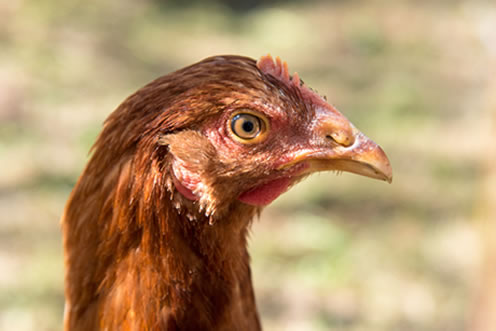Did you know that the domesticated chicken is the living genetic relative of the Tyrannosauridae (T-rex) dinosaur? Or that newly hatched chicks can add and subtract numbers – and exhibit other skills and abilities beyond that of a human toddler? Did you know that chickens have at least 25 different types of vocal communications used to convey various situations and feelings? Or that they prefer to perch high in tree branches if given the opportunity?
Origin
The chicken is a subspecies of the wild red jungle fowl that originated from Asia going back as far as 50 million years. It is believed that the wild chicken first became domesticated anywhere from 8,000 to 10,000 years ago due to its close proximity to human civilization — and its initial domestication occurred more for religious and sport purposes than for a food source for humans. Egyptians initially used chickens for cock fighting but later developed a way to incubate fertilized eggs, while Roman priests raised sacred chickens used for fortune telling and omens.
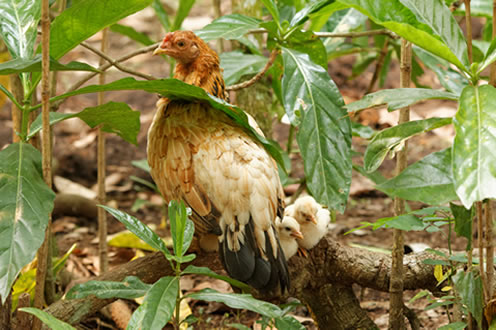 Natural Needs, Tendencies and Preferences
Natural Needs, Tendencies and Preferences
There are over 50 different types of chickens in existence today — all descended from the red jungle fowl. Chickens live together in families and travel in flocks. Socially, chickens rely on a hierarchical order, or pecking order, within their groups or flocks. Chickens in the wild form flocks of no more than 15; larger flocks of 25 or more chickens and more than one rooster can result in fighting as they all try to maintain the pecking order.
Chickens are omnivores and in addition to the seeds, nuts, grains and berries found in the wild, they will also eat insects, seeds, and sometimes lizards, small snakes or young mice.
Chicken Environment
Hens begin to lay eggs at 16 to 20 weeks of age. Under normal (natural) conditions, hens will usually lay around 12 eggs and then incubate them for approximately three weeks. If a rooster fertilizes the eggs, they will hatch. Baby chicks remain with their mother for several weeks, protected by her and taught to find food and water.
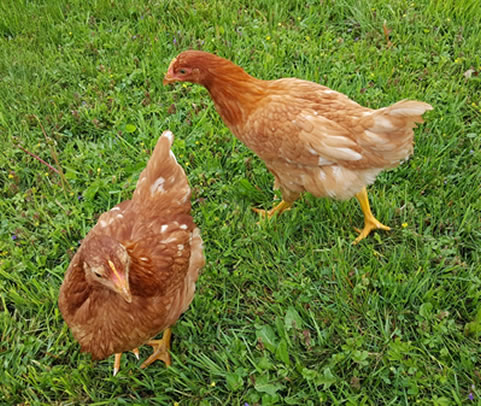 Chickens can live between five to ten years in a natural environment.
Chickens can live between five to ten years in a natural environment.
Chickens prefer to roost or perch in high locations off of the ground at night to avoid predators, as total darkness causes chickens to go into a type of stupor. They love to take dust baths, which helps to keep them cool in warm weather and also aids in parasite control.
Chicken Intelligence
Chickens are intelligent and possess communication skills on the same level as primates. They exhibit basic arithmetic abilities, self control, geometry, physics, advanced problem-solving, basic structural engineering, and are fast learners with the ability to retain information. And they display emotions such as grief, fear and happiness, and can express an empathetic response to their chicks and toward other chickens in distress. Chickens can recognize over 100 individual faces. They can retain things they’ve learned from prior experiences – and recall and apply these lessons toward future situations.
Chickens exhibit individual personalities and emotions, and can respond to their names and come when called (similar to a dog). Chickens feel pain and are self-aware and clever.
What’s Changed — A Chicken’s Life Today
Well into the 20th century, people valued chickens only as a source of eggs; chickens played little part in the American diet and economy. But once people enhanced chicken feed with vitamins and antibiotics, they began to raise chickens indoors in mass quantities.
Today, chickens and turkeys represent 99% of all animals killed for food in the U.S. (with 9 billion in the U.S. and approximately 40 billion worldwide killed each year).
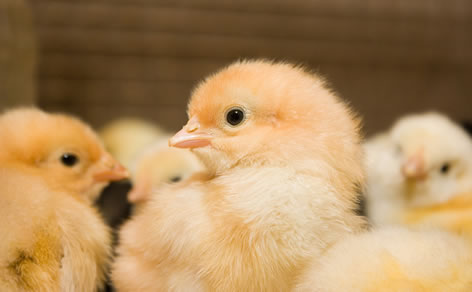 Chickens for Meat
Chickens for Meat
Unfortunately, the abuse begins with the babies. Since producers have no use for male chicks in the egg or poultry business (because they artificially inseminate all females), they suffocate or throw the chicks (fully conscious) into a grinder to crush them.
Female chickens bred for their “meat” (aka: “broilers”) are genetically altered to produce such huge breasts that their legs cannot hold their weight and they are unable to stand for much of their lives. Hundreds of millions of chickens die every year before reaching the slaughterhouse at six weeks of age. Factories typically crowd these birds by the thousands into huge factory-like warehouses where they can barely move; a single shed or grower house contains up to 20,000 chickens. Mass producers give chickens less than half a square foot of space each.
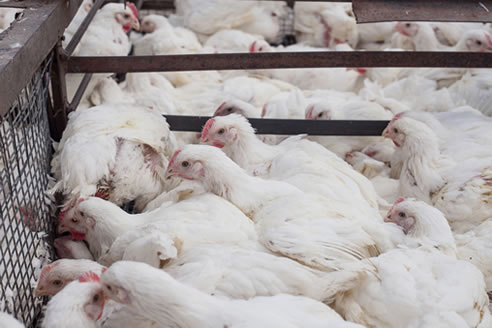 Chickens have the end of their beaks cut off; known as debeaking, this painful procedure (done without anesthesia) involves cutting through bone, cartilage, and soft tissue. Producers perform this mutilation to reduce injuries which result when stressed birds are driven to fighting. Confined in unhealthy factory farms, the birds also succumb to heat prostration, infectious disease, and cancer.
Chickens have the end of their beaks cut off; known as debeaking, this painful procedure (done without anesthesia) involves cutting through bone, cartilage, and soft tissue. Producers perform this mutilation to reduce injuries which result when stressed birds are driven to fighting. Confined in unhealthy factory farms, the birds also succumb to heat prostration, infectious disease, and cancer.
Chickens for Eggs
Chicken producers cut off part of the beaks of hens raised for eggs. This practice reduces chicken injuries resulting from excessive pecking, a behavior that occurs when confined hens are bored and frustrated. They then confine the hens in battery cages. These are small wire cages egg producers stack in tiers and line up in rows in huge warehouses. The USDA recommends giving each hen four inches of feeder space, which means packing four hens in a cage just 16 inches wide. The birds cannot stretch their wings or legs, and they cannot fulfill normal behavioral patterns or social needs. As a result, the constant rubbing against the wire bars causes the chickens to lose feathers, and incur bruises and abrasions.
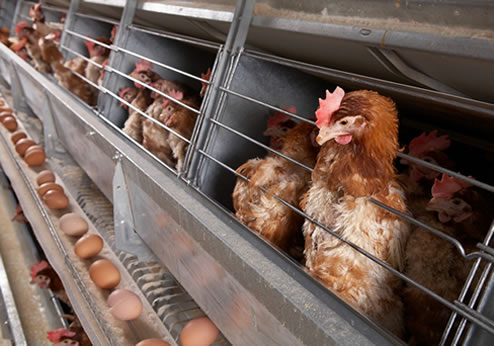 After one year of egg production, the birds are classified as spent hens and sent off to slaughter. They usually end up in soups, pot pies, or similar low grade chicken meat products. In this way, producers can shred their bodies to hide the bruises from consumers.
After one year of egg production, the birds are classified as spent hens and sent off to slaughter. They usually end up in soups, pot pies, or similar low grade chicken meat products. In this way, producers can shred their bodies to hide the bruises from consumers.
And because chickens are intelligent, have a long memory, and can feel their own pain and empathy toward the pain of others, those exploited in the meat and egg industries are forced to endure a tremendous degree of psychological and physical suffering. They live their short unhappy lives without ever experiencing fresh air, grass or sunshine. Because of this, factory farms prevent chickens from fulfilling any of their natural needs, habits or behaviors.
Cause and Effect
If you can set aside the matter of the inhumane and cruel treatment of these intelligent birds, think about the tremendous amounts of resources required to raise billions of them in confined factory farms — not to mention the pollution from tons of manure and ammonia emitted back out into the environment.
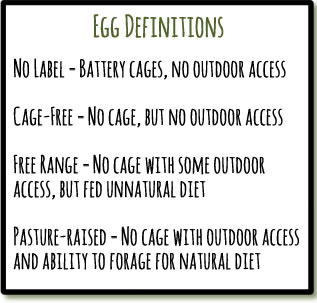 And then when you throw in the fact that chicken meat and eggs contain cholesterol, saturated fat, arsenic, and bacteria which adversely impact human health, the idea of choosing other animal, earth and human health-friendly chicken and egg alternatives seems like a very good idea all the way around.
And then when you throw in the fact that chicken meat and eggs contain cholesterol, saturated fat, arsenic, and bacteria which adversely impact human health, the idea of choosing other animal, earth and human health-friendly chicken and egg alternatives seems like a very good idea all the way around.
What Happens Next
As the demand for chicken meat and eggs declines, so will the mass production of them. Planet earth simply cannot continue to support and absorb the impact of these large-scale chicken and egg operations — the tons of manure, the water pollution, or the air pollution. And the human body cannot continue to tolerate the consumption of a product that is unhealthy for it and does not meet its nutritional needs or enable it to ward off diseases.
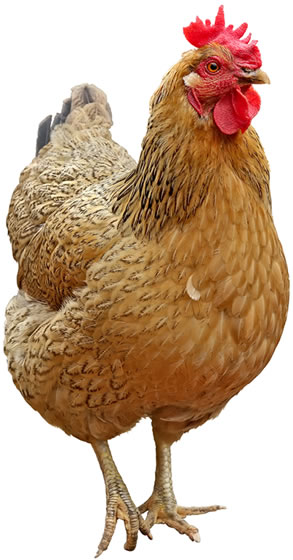 In conclusion, as more consumers become aware of the horrible treatment of these sentient beings, the demand for eggs and chicken will continue to decrease. Meanwhile, consumer demand has increased for organic pasture-raised eggs. This is because people are willing to pay more for a carton of eggs if they believe the sellers treated the chickens humanely. We are slowly seeing progress made in the elimination of raising chickens in battery cages; more producers are feeling consumer pressure to allow space for egg-laying chickens by not confining them to small cages.
In conclusion, as more consumers become aware of the horrible treatment of these sentient beings, the demand for eggs and chicken will continue to decrease. Meanwhile, consumer demand has increased for organic pasture-raised eggs. This is because people are willing to pay more for a carton of eggs if they believe the sellers treated the chickens humanely. We are slowly seeing progress made in the elimination of raising chickens in battery cages; more producers are feeling consumer pressure to allow space for egg-laying chickens by not confining them to small cages.
More Information About Chickens
Good article on the history of the chicken: http://blogs.lt.vt.edu/chickens/2013/05/01/evolutionary-history-of-the-chicken-pigeon-and-other-birds/
Cage-free vs. battery cages: http://www.humanesociety.org/issues/confinement_farm/facts/cage-free_vs_battery-cage.html
Chicken intelligence: http://www.dailymail.co.uk/sciencetech/article-2344198/Chickens-smarter-human-toddlers-Studies-suggest-animals-master-numeracy-basic-engineering.html
Chicken intelligence video: https://www.youtube.com/watch?v=25RcDO2RdZQ
Gory Details / Other Articles
http://www.peta.org/issues/animals-used-for-food/animals-used-food-factsheets/poultry-eggs-industries-abuse-chickens/
http://www.farmsanctuary.org/learn/factory-farming/chickens/#eggs
Sources for this Article
Evolutionary History of the Chicken, Pigeon and Other Birds, May 1, 2013, Learning Technologies, Virginia Tech
How Did Chickens Evolve, and When Did Humans Start Eating Them? http://www.quora.com
Basic Chicken Behaviors – For Dummies; http://www.dummies.com
Chicken; http://www.en.wikipedia.org
Chicken Behavior: An Overview of Recent Science; http://freefromharm.org

